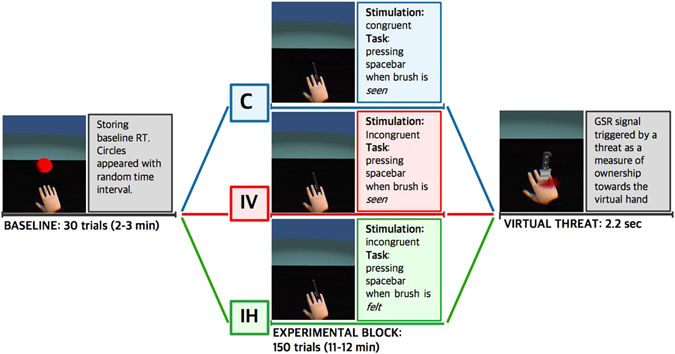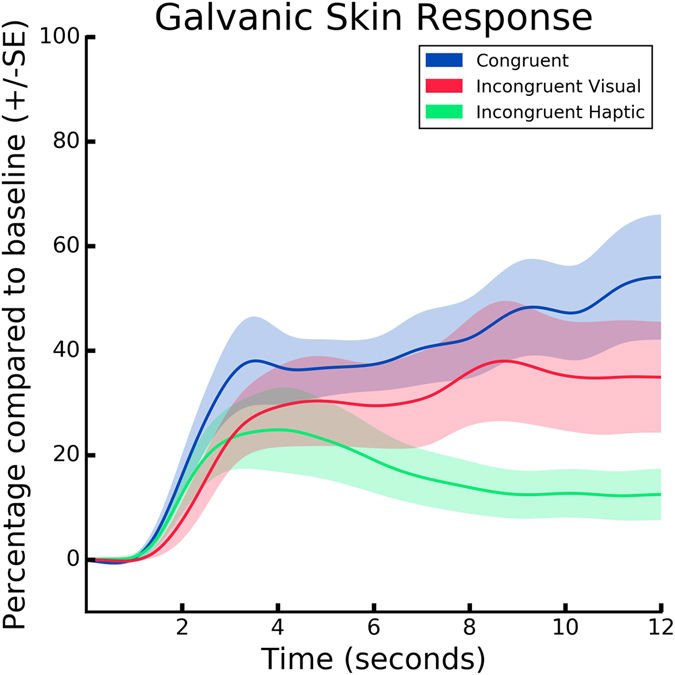The sense of body ownership influences decision making and motor performance
The SPECS Research Group, led by ICREA Professor Paul Verschure, has conducted a study published recently in Scientific Reports that demonstrates this relationship through behavioural experiments with healthy individuals.

Through the research, led by Klaudia Grechuta of SPECS as leading author, it is observed that, having induced the ownership of a virtual arm in an individual, there is a marked physiological response that makes him respond to stimuli that threaten him, such as a hammer blow or a knife wound. This effect is caused by an increase in skin conductance, measured through an electrodermal response.
In this way, the feeling that the body belongs to oneself depends on how the internal representation of the body coincides with the sensory input we receive. The brain then chooses the best option to establish body ownership.
 The experimental and clinical research conducted suggests that the neural substrates to determine the ownership of the body and the systems that control the fine motor are connected anatomically, including structures such as the ventral premotor cortices, the temporal-parietal junction (TPJ) and the insula. The researchers thus interpret these results as the possibility that there is a functional coupling between body ownership and decision-making and action execution.
The experimental and clinical research conducted suggests that the neural substrates to determine the ownership of the body and the systems that control the fine motor are connected anatomically, including structures such as the ventral premotor cortices, the temporal-parietal junction (TPJ) and the insula. The researchers thus interpret these results as the possibility that there is a functional coupling between body ownership and decision-making and action execution.
The study tests this hypothesis through a behavioural paradigm, investigating whether different degrees of experimentally-induced body ownership can modulate response times on a simple motor task. This modulation is achieved through the systematic alteration of the ownership of a virtual arm using the Rubber Hand Illusion (RHI) paradigm through Virtual Reality (VR).
Therefore, the researchers devised a protocol to experimentally induce ownership of a virtual hand in healthy subjects. They subsequently determined response times in a sensorimotor task in which participants were asked to provide rapid motor responses to sensory stimuli by pressing a button.
The results confirm that the degree of ownership of a virtual hand depends on the intermodal processes of visuotactile stimulation, measured subjectively (self-report) and objectively (Galvanic Skin Response, GSR). In addition, a hitherto unidentified effect on the performance itself has been observed. The subjects with “high” ownership condition also showed quicker reaction times when they had to perform actions with the virtual hand. Finally, the study also shows, surprisingly, that sensory modalities have varying effects on the induction of ownership. Not only is the congruence of multimodal feedback important, but also seeing what is the weight of the sensory stimuli that are acting. In this case, sight has a more important effect than touch.
This research was supported by the Spanish Ministry of Economy, Industry and Competitiveness, the European Research Council and the European Social Fund in the Czech Republic.
Possible developments in the field of neurological rehabilitation
The applications of the paradigm presented could be relevant in areas such as the neurological rehabilitation of patients who have suffered some kind of brain accident. In fact, SPECS, the laboratory which carried out these experiments, led by Paul Verschure, has a long tradition in the use of brain theory and virtual reality in interventions to repair brain damage.
The current study can further improve these interventions by inducing ownership towards the virtual body. In addition, additional clinical studies are being carried out to evaluate whether this method can be applied to hemiparetic stroke patients and if virtual reality-induced ownership can have a more positive influence in the process of recovery.
This approach has been used, for example, to develop the Rehabilitation Gaming System, one of the most advanced and effective interventions currently available in many hospitals and rehabilitation centres.
Reference work:
Grechuta K; Guga J; Maffei G; Ballester Rubio B and Verschure P. Visuotactile integration modulates motor performance in a perceptual decision-making task, Scientific Reports, 2017. DOI: 10.1038/s41598-017-03488-0
